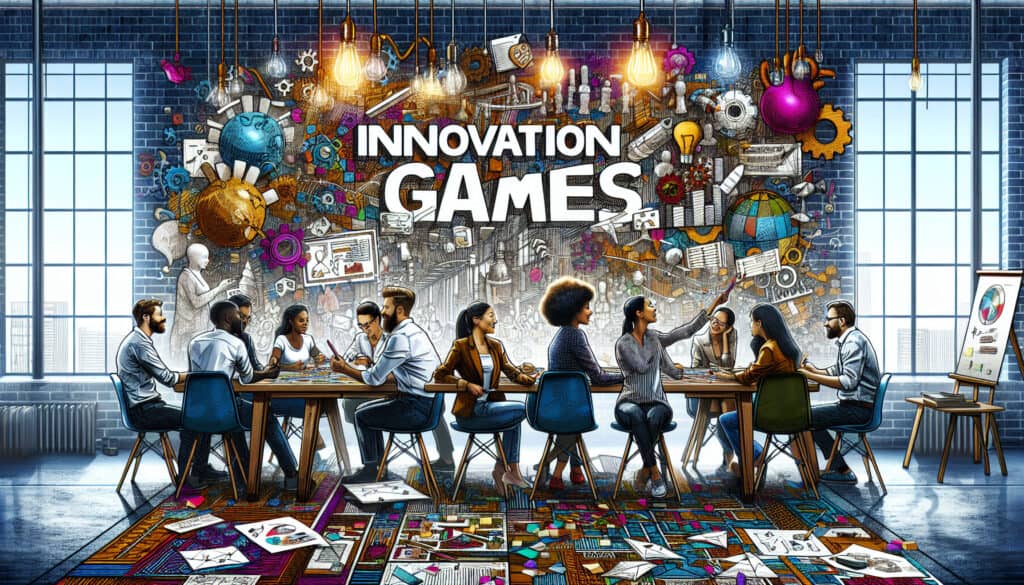Un conjunto de ejercicios colaborativos para comprender las necesidades de los clientes y diseñar nuevos productos.
- Metodologías: Clientes y marketing, Ideación, Diseño de producto
Juegos de innovación

Juegos de innovación
- Metodología ágil, Experiencia del cliente, Trayectoria del cliente, Pensamiento de diseño, Innovación, Estudios de mercado, Creación de prototipos, Experiencia de usuario (UX), Diseño centrado en el usuario
Objetivo:
Cómo se utiliza:
- Conjunto de métodos de investigación cualitativa que utilizan juegos para ayudar a los clientes a expresar sus necesidades y deseos. Estos juegos están diseñados para ser más atractivos y reveladores que las técnicas tradicionales de investigación de mercado.
Ventajas
- Puede ser más atractivo y divertido que los métodos de investigación tradicionales.
Contras
- Puede llevar mucho tiempo y ser costoso; requiere un facilitador cualificado.
Categorías:
- Clientes y marketing, Diseño de producto
Ideal para:
- Comprender las necesidades de los clientes y diseñar nuevos productos y servicios de forma colaborativa y atractiva.
Los juegos de innovación pueden ser especialmente beneficiosos en sectores como la tecnología, los bienes de consumo, la sanidad y la automoción, en los que comprender las necesidades de los usuarios es fundamental para el desarrollo de productos. Estas atractivas metodologías pueden utilizarse en varias fases del proyecto, especialmente durante la ideación y la validación del concepto, a menudo siguiendo enfoques de investigación tradicionales para enriquecer los datos recopilados. En las sesiones suelen participar equipos multidisciplinares formados por diseñadores de productos, ingenieros, especialistas en marketing y clientes reales, que colaboran para dar forma a los conceptos de producto a partir de las reacciones del mundo real. Los formatos de juego específicos, como "Product Box" o "Empathy Mapping", animan a los participantes a expresar sus pensamientos de forma creativa, lo que permite una exploración más profunda de los deseos y los puntos de dolor más allá de las respuestas superficiales. Estas sesiones pueden facilitarse en talleres, sprints de diseño o grupos focales, lo que las hace adaptables a distintas culturas organizativas. Además, la naturaleza lúdica de estos juegos puede reducir la presión que suelen sentir los participantes durante las entrevistas convencionales, lo que da lugar a respuestas más auténticas y sinceras. La combinación de actividades divertidas y estructuradas genera un rico tapiz de datos cualitativos que, en última instancia, contribuyen a soluciones de producto más innovadoras y centradas en el cliente.
Pasos clave de esta metodología
- Elija un tipo de juego específico apropiado para el objetivo de la investigación.
- Facilite el juego, asegurándose de que los participantes entienden las reglas y los objetivos.
- Fomentar el diálogo abierto entre los participantes durante el juego.
- Observe las interacciones y anote los temas e ideas que surjan.
- Capture los resultados visuales y verbales generados durante el juego.
- Debrief con los participantes para explorar los significados más profundos de sus contribuciones.
- Identificar patrones y agrupaciones a partir de los resultados recogidos.
- Traducir las conclusiones en conceptos de productos o servicios viables.
Consejos profesionales
- Incorpore elementos de rol a los juegos para crear escenarios realistas que revelen motivaciones y puntos débiles más profundos en torno al uso del producto.
- Utilizar métodos mixtos en los Juegos de Innovación, combinando datos cualitativos de los resultados de los juegos con datos cuantitativos de la investigación tradicional para obtener un análisis completo.
- Fomentar sesiones colaborativas de intercambio de ideas después del partido para sintetizar los hallazgos y directamente comprometer los participantes a la hora de priorizar sus necesidades y deseos.
Leer y comparar varias metodologías, recomendamos el
> Amplio repositorio de metodologías <
junto con otras más de 400 metodologías.
Sus comentarios sobre esta metodología o información adicional son bienvenidos en la dirección sección de comentarios ↓ , así como cualquier idea o enlace relacionado con la ingeniería.
Contexto histórico
1949
1950
1950
1960
1960
1960
1960
1940
1950
1950
1958
1960
1960
1960
1960
(si se desconoce la fecha o no es relevante, por ejemplo "mecánica de fluidos", se ofrece una estimación redondeada de su notable aparición)















Publicaciones relacionadas
Cuestionarios sobre molestias musculoesqueléticas
Pruebas multivariantes (MVT)
Análisis de regresión múltiple
Sistemas de captura de movimiento
Método MoSCoW
Prueba de la mediana de Mood